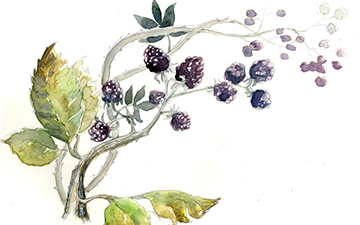Rubus ursinus is a species of blackberry or dewberry known by the common names California blackberry/dewberry, Douglas berry, Pacific blackberry/dewberry and trailing blackberry. It is native to western North America. This is a wide, spreading shrub or vine-bearing bush with prickly branches that can tip layer to spread vegetatively. Its white flowers may be distinguished from those of other blackberries by their narrow petals. The species is dioeocious, with male and female plants. As with other Rubus, the canes are typically vegetative the first year, primocanes, and reproductive in the second, floricanes. The sweet, very aromatic, edible fruits are dark purple to black and up to 2 centimeters in length.
They need consistent amounts of moisture to set large fruit. In coastal areas of Washington state they are called “little wild blackberries”. Seed size seems to be related to fruit “cell” size, and the smallest (1 cm) fully formed berries are most highly prized.
A selected plant of this species called the ‘Aughinbaugh’ blackberry was a parent of the Loganberry. The species is also an ancestor of the Boysenberry, and the Marionberry (also called ‘Marion’ blackberry). ‘Wild Treasure’, released by the USDA-ARS in 2010, is a hybrid between a selection of R. ursinus and ‘Waldo’ (another cultivar that is a second generation descendant of ‘Marion’ that has no prickles); it has the fruit size and flavor of the wild species, but without prickles, and the fruit are machine harvestable.
The Concow tribe calls this plant wân-kö-mil′-ē (Konkow language).[2]
(From Wikipedia, September 2013)




